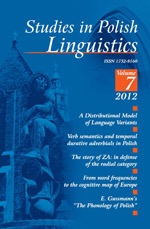Morfofonologiczne podejście do mutacji spółgłoskowych w języku polskim.
Modelling morpho-phonology: consonant replacements in Polish
Author(s): Sławomir ZdziebkoSubject(s): Language and Literature Studies
Published by: Wydawnictwo Uniwersytetu Jagiellońskiego
Keywords: morpho-phonology; palatalization; Government Phonology; consonant replacements; Distributed Morphology
Summary/Abstract: Gussmann (2007) put forward a morpho-phonological analysis of Polish palatalizations which is an alternative to traditional re-write rules promoting abstractness in phonology. The aim of this article is to turn Gussmann’s descriptive tool into a coherent theory. In order to do that I propose a set of premises that regulate the working of the component of morpho-phonology. Among these premises the Minimalist Hypothesis (Kaye 1992) and the Locality Principle occupy the most prominent position. The former says that all morpho-phonological replacements work whenever their conditions are met (no (counter)bleeding or counterfeeding is possible), whereas the latter limits the scope of morpho-phonological replacements to nodes entering the relation of concatenation (Embick 2010). The last part of the article is devoted to the cases that apparently violate the Minimalist Hypothesis. These are the replacements that Gussmann (2007) subsumes under the label P(alatalization) R(eplacement) 7. The article shows that the problematic replacements presented as PR7 may be convincingly analysed as root-specific and thus do not constitute counterexamples to the Minimalist Hypothesis.
Journal: Studies in Polish Linguistics
- Issue Year: 7/2012
- Issue No: 1
- Page Range: 129-164
- Page Count: 36
- Language: English

